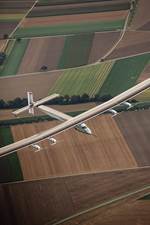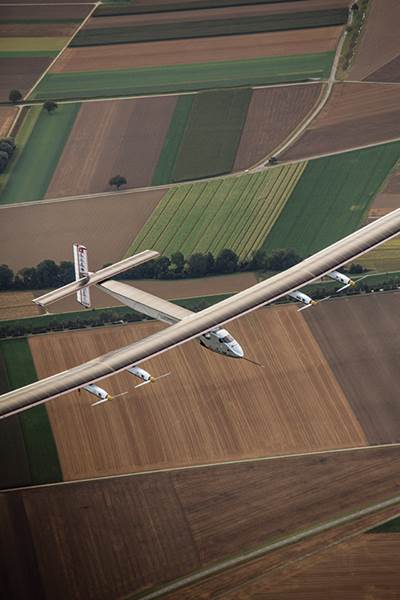Round-the-world flight progress: Solar Impulse 2
Energized only by sunlight taken in by the solar panels arrayed on its horizontal surfaces, the electric-prop-driven, all-composite-airframed Solar Impulse (Si2) aircraft had completed nearly one-half of its much publicized ‘round- the-world trip as CW’s May issue went to press.
Energized only by sunlight taken in by the solar panels arrayed on its horizontal surfaces, the electric-prop-driven, all-composite-airframed Solar Impulse (Si2) aircraft had completed nearly one-half of its much publicized ‘round- the-world trip as CW’s May issue went to press. It took off the morning of March 9 on the first leg from Abu Dhabi, UAE, under the watchful eyes of the Solar Impulse team there and its Mission Control Center in Monaco. André Borschberg lifted off in Si2 at 7:12 a.m. (GMT +4) on Monday, carrying no backup fuel supply or alternative means of propulsion, headed for Muscat (Oman) before crossing the Arabian Sea to Ahmedabad (India) on the first leg of what
is intended to be a round-the-world flight. Borschberg’s partner and the aircraft’s co-developer, Bertrand Piccard, took the controls in Oman and continued on to Ahmedabad. Piccard and Borschberg have since alternated as pilots of the single-seater experimental solar aircraft, completing three additional legs of its world tour. Si2 took off for its fourth flight on March 18, piloted by Piccard, from Varanasi (Lal Bahadur Shastri Airport) in the Republic of India, to Mandalay International Airport in the Republic of the Union of Myanmar, landing at 23:52 UTC (see photo). Piccard flew the airplane about 1,408 km for about 20 hours.
At CW press time, the Si2 Team was about to embark on leg 6, from Chongqing, China to
Nanjing, China, which had been delayed by poor weather. Assuming a successful flight to
Nanjing, the next leg is a much more ambitious, nonstop flight from China to Hawaii.
The Solar Impulse company noted, on the occasion of the event, that it has taken 12 years for Piccard (the development program’s initiator and chairman) and Borschberg (founder and CEO), to reach the point where they could demonstrate in such a fashion the importance of renewable energy.
Capable of flying over oceans for several days and nights in a row, Solar Impulse is scheduled, during the RTW trip, to travel a total of 35,000 km in 25 days over the course of roughly five months. Piccard and Borschberg are required to demonstrate extraordinary endurance in a 3.8m3 unpressurized, unheated cockpit, with external temperatures ranging from -40°C to +40°C. Si2 has successfully passed over the Arabian Sea, India and Myanmar. After reaching China and negotiating the Pacific Ocean with a stopover in Hawaii and an Americas leg, it will cross the Atlantic Ocean — the lengthy ocean crossings are expected to be the technology’s greatest tests and the adventure’s highlights. The final legs include a stopover in Southern Europe or North Africa before completing the round-the- world flight at its final destination in Abu Dhabi, Solar Impulse’s official host city. During scheduled stops, the Solar Impulse team and its partners have held and will hold public events.
Supported by Prince Albert of Monaco, UAE Minister of State and Chairman of Masdar H.E. Dr. Sultan Al Jaber, Richard Branson and Al Gore, the #FutureIsClean initiative has been launched on www.solarimpulse.com to recruit support for the adoption of clean technologies worldwide. Of the challenge, Piccard and Borschberg have said: “We are very ambitious in our goal, but modest, given the magnitude of the challenge. This is an attempt, and only time will tell if we can overcome the numerous weather, technical, human and administrative issues.”
Solar Impulse is an airborne laboratory, made from technological solutions developed by a team of 80 specialists and more than 100 partners and consultants. Si2 is the largest aircraft ever built with such a low weight, equivalent to that of a small car. With a wing larger than that of a Boeing 747 covered by more than 17,000 solar cells, the plane can fly up to an altitude of 8,500m at 50-100 kmh.
Related Content
Thermoplastic composites welding advances for more sustainable airframes
Multiple demonstrators help various welding technologies approach TRL 6 in the quest for lighter weight, lower cost.
Read MoreCarbon fiber in pressure vessels for hydrogen
The emerging H2 economy drives tank development for aircraft, ships and gas transport.
Read MoreMaterials & Processes: Composites fibers and resins
Compared to legacy materials like steel, aluminum, iron and titanium, composites are still coming of age, and only just now are being better understood by design and manufacturing engineers. However, composites’ physical properties — combined with unbeatable light weight — make them undeniably attractive.
Read MoreCryo-compressed hydrogen, the best solution for storage and refueling stations?
Cryomotive’s CRYOGAS solution claims the highest storage density, lowest refueling cost and widest operating range without H2 losses while using one-fifth the carbon fiber required in compressed gas tanks.
Read MoreRead Next
Spread-tow technology takes off
New, ultralight-areal-weight prepreg tapes form the thin-ply laminates will enable Solar Impulse 2’s sun-powered flight around the world.
Read MoreComposites end markets: Energy (2024)
Composites are used widely in oil/gas, wind and other renewable energy applications. Despite market challenges, growth potential and innovation for composites continue.
Read MoreCW’s 2024 Top Shops survey offers new approach to benchmarking
Respondents that complete the survey by April 30, 2024, have the chance to be recognized as an honoree.
Read More














.jpg;maxWidth=300;quality=90)










